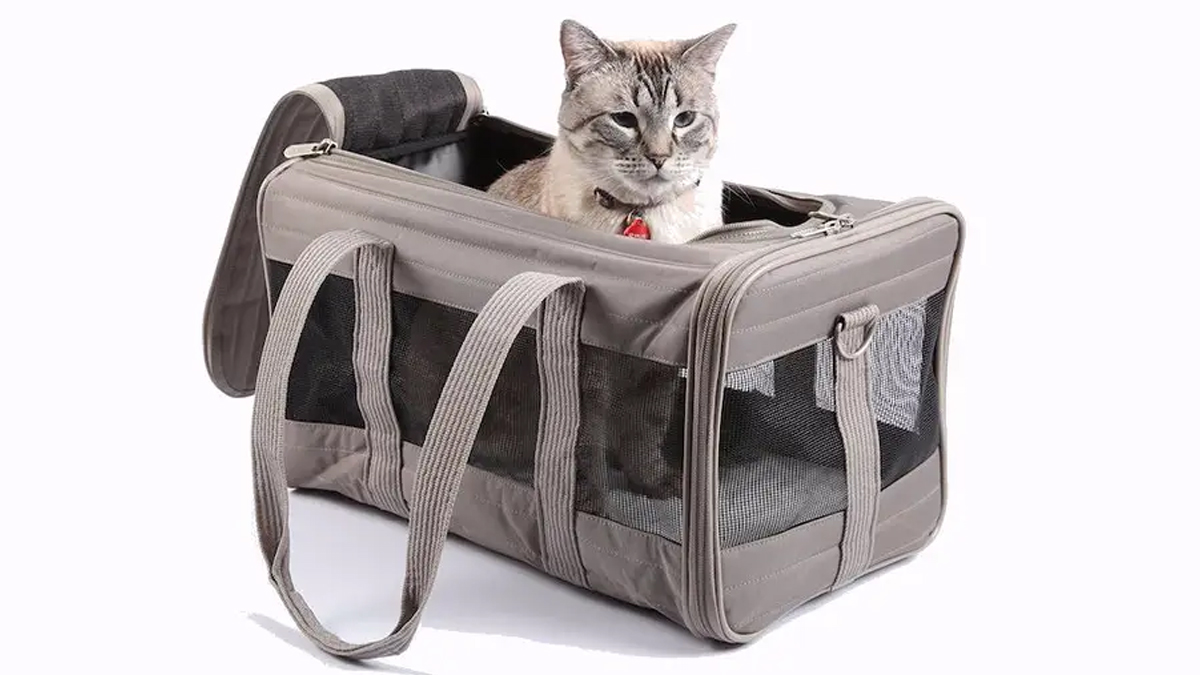on
Evacuating with dogs is relatively easy be it in a vehicle or on foot. You can train them to load up in a travel crate on command and even teach them to carry their own packs if you are on foot. But what can you do to make sure your cat has a chance to survive too?
Contrary to popular belief cats can be trained. Ok, stop laughing, it is true, they can be trained or at the very least they can become accustomed to, or even learn to enjoy certain things like going for walks on a harness/leash system.
Preparing your cat to evacuate by vehicle:

- Selecting the right carrier for your cat. A cat carrier, securely fastened in your vehicle is the safest ways to transport your cat(s) not only does it prevent escapes when doors are opened, but it keeps your cat from interfering with your driving.
Cats should be able to stand, sit, and turn around in their carrier. Generally, a carrier should be one and a half times the size of your cat. If the carrier is too big it can be uncomfortable trying to balance and carry the carrier without having your cat slide from one side to another.
Tip: A top-loading carrier is usually easier to get a cat into in a hurry. Especially if they have picked up on your nervousness in an emergency situation. - Teach your cat to enter the carrier on command. My cats understand the same command as my dogs “go kennel”. Two of them were still babies when rescued so they went to work with me every day for a couple of months and to them hoping in a kennel meant a fun day ahead. The above link gives step by step directions on how to teach your cat to go in the carrier on command.
- Accustom your cat to travel. If every trip your cat takes is to the vet they will quickly associate their carrier with an unpleasant experience. Let them explore the vehicle while it is parked, but never travel with them outside of their carrier – furry projectiles are not good for anyone! Work your way up to short rides that don’t involve going to the vet. Maybe a visit to a friend they already know and like, even if it is just a short meet, greet and treat.
Preparing your cat to evacuate on foot
Some cats prefer to spend their life snoozing on the sofa, while others have a more adventurous spirit and can be trained to accept a harness and leash as a safe way to explore the outdoors. Before you evacuate is the time to find out if your cat is willing to walk on a leash, and when you end up having to carry them, how much weight you are able and willing to haul.

- Selecting the right harness for your cat. Unlike dogs, cats have soft throats and can choke if walked with just a collar, so a well-fitting harness that they can’t escape is a must. Check out the above link to see recommendations to help you select the right harness for your cat.
- Leash train your cat. Once your cat has grown accustomed to wearing the harness it is time to start leash training. Just like with training them to accept a carrier, training needs to be done gradually for short periods and building up to longer periods starting indoors and working up to outdoor training and eventually longer walks.
- Take your cat hiking. Cats do not have the same stamina as dogs and they do not like to get wet so you need to be prepared to help your cat over water obstacles. Also, be prepared to carry your cat, some people have had success bringing a soft side carrier that they attack to their backpack and others choose to bring a front pack. Since front packs often have large “windows” it allows the cat to enjoy the view without the effort. As with any carrier you need to accustom your cat to it before you are out on the trail. Don’t forget to also pack food and water for your cat.
Preparing homemade cat food
The stores are closed, you are out of commercially produced cat food either temporarily or for a longer duration. While hunting is instinctive for cats, if they weren’t raised doing it their success rate may not be good enough to keep them fed.
Because cats are obligate carnivores they must eat meat. Although cats don’t require you to cook for them, raw diets do run a slight risk of salmonella for both the cat and the human preparing the food.
So what does homemade raw cat food consist of? Most importantly, it is more than just meat. It’s made up of meat, organs, bone, fat, egg yolks, water and supplements. All of these ingredients are necessary to make a balanced diet for complete cat nutrition. The goal is to mimic the natural prey-based diet of cats.

There are a lot of recipes out there for preparing homemade cat food and most are designed for you to prepare a week or two worth of food at a time. Most of these recipes could be made from your own personal stash of freeze-dried proteins or from fresh ingredients.
Stocking up on commercial cat food
Properly stored unopened dry cat food can have a shelf life of up to 2 years, but that number varies greatly among brands. Similarly, canned cat food has a shelf-life of 1-5 years depending on the brand. So it pays to do your research and figure what brand your cat will eat with the longest shelf life and then just like with your own food, you need to rotate for stores to keep your stockpile as fresh as possible.
Get access to premium content and more!





